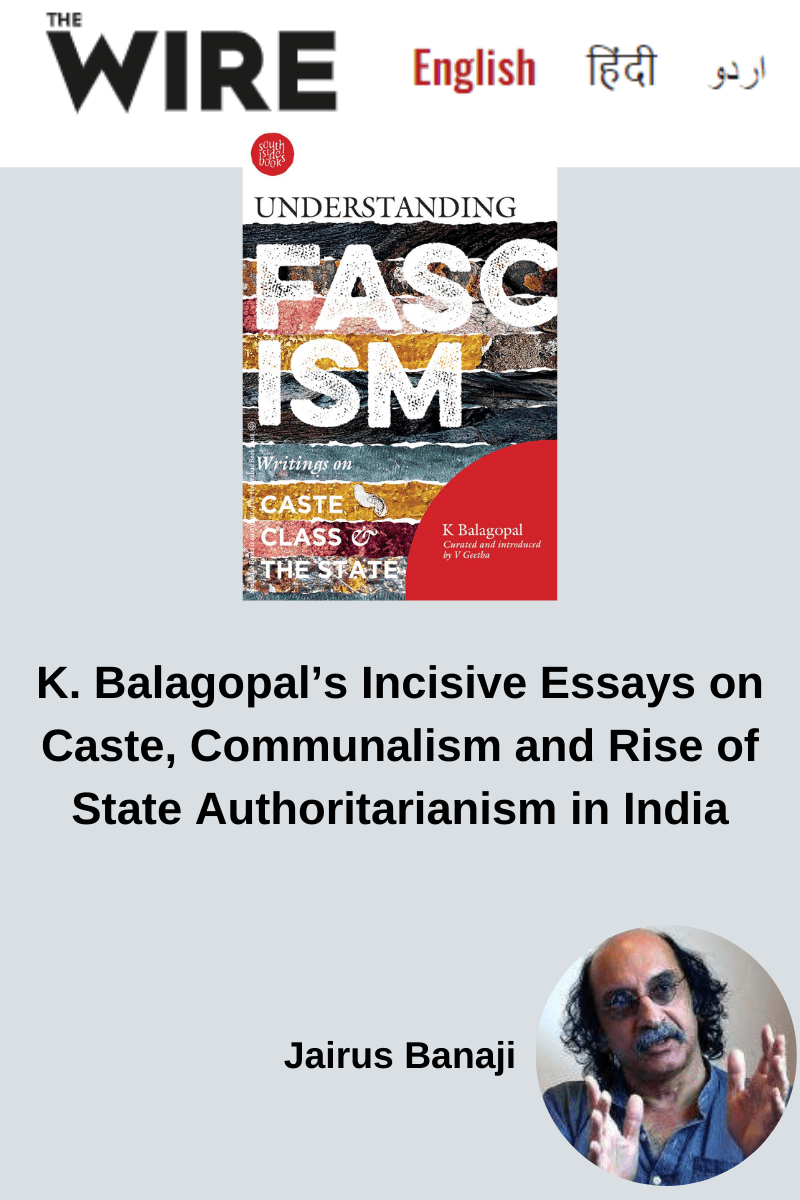
The writings between the 1980 and 2003 of K. Balagopal, the scholar and democratic rights activist who died too early, emphasised caste’s role in fuelling fascism in India.
Understanding Fascism: Writings on Caste, Class and the State
By K Balagopal, Curated and introduced by V. Geetha
SouthSide Books, 2023, 242 pages, Rs. 400
We are situated at the moment of the “complex and monstrous maturation” of the Republic, as V. Geetha puts it in her Introduction to this significant collection of essays by K. Balagopal, a scholar and democratic rights activist we lost too soon. Some of the essays serve the function of bearing witness—the ones on the Karamchedu and Chundur massacres, for instance, many of the essays on police violence, and one written after the Gujarat massacre in 2002. Others are more analytical and reflective—a political appraisal of Indira Gandhi, and several essays on caste/class and religious fundamentalism.
Geetha has arranged this selection of essays into three themes—fascist possibilities studied through caste and class configurations in post-Independent India; Hindutva as a response to egalitarian aspirations; and, third, police brutality and rule of law.
In this review I will focus on the first two themes as they offer significant theoretical insights for the present. Reading these pieces from the 1980s to 2003 now, one is struck by Balagopal’s needle sharp focus on “fascism” in his critique of Indian democracy, a term whose applicability has come to be adopted and debated seriously in the mainstream only in recent decades.
His analysis of fascism in the Indian context sees caste as one of the key factors in its functioning. Consider the essay “Anti Reservations, Yet Once More” (1986), a striking analysis of the protests in Andhra Pradesh by upper-caste and upper-class youth against the implementation of reservations for Backward Classes (BCs) on the basis of the Muralidhar Rao Commission. This analysis is worth discussing at length because it moves from Andhra and this particular agitation to make a much larger argument about India’s social structure and democracy.
Balagopal offers a fascinating argument, drawing on the intersection of political economy and historical developments in the class-caste-tribe nexus. A large part of the history of India, he says, can be told in terms of “the transformation of endogamous groups or communities (loosely called tribes) into castes”. The distinction he makes between the tribe and the caste is that although both are endogamous, the tribe was an autonomous entity as a unit of production (with production including “primitive direct appropriation of the fruits of nature”); while the caste is positioned within a larger unit of production with a specific economic role. I understand Balagopal to be saying that the drawing of tribes into larger production processes was their transformation into castes within the Brahminical hierarchy.
The argument goes on to say that just as tribes are localised, so are castes. Of the hundred-odd Backward Classes identified in Andhra, a very large number, Balagopal points out, are confined to small regions. Subsequent to this transformation, two significant developments take place. The former tribal community splits into two, indicating, he says, a class division—a large number of castes exist in pairs, one backward and one forward, the difference being indicated by a prefix. The upper sections take to trade or cultivation; the lower sections remain food gatherers or become labourers.
The next stage is that class consolidation takes place, based on substantial landholding or trade, across the upper sections of different communities spread out over a large area. This becomes a fresh grouping, but endogamy is maintained and reproduced in this new class formation so that “what should have become a class of substantial landholders becomes one more caste. This appears to be the genesis of all the dominant landed castes”. Balagopal concludes that there is no other way to account for the wide spread of dominant castes as opposed to the localisation of Backward Class cultivating castes.
This analysis was set off by the question he poses as to why the Backward Classes were unable to unite and defend their rights in a similarly public manner as the dominant castes were able to attack reservations. He suggests that the answer lies in the localisation of cultivating Backward Classes in contrast to the wide spread of landholding upper castes. He then issues a warning—that “the fascist possibilities inherent in a widespread and rapidly consolidating class of new rich are familiar to history”, and when that class can draw on lower middle-class caste fellows as foot soldiers, “the danger becomes more serious”.
Thus, significantly, in this 1986 essay he indicates the potentialities in Indian democracy for fascist mobilisation deriving from caste consolidation, long before the anti Mandal agitations and the Hindutva campaigns leading up to the demolition of the Babri Masjid. This provocative and original thesis could offer a rewarding frame for more empirical research by younger scholars today.
Balagopal thus reframes fascism (by way of a discussion on reservations), in terms of class for those who take caste to be primary and in terms of caste for the Left, which had tended to work on the assumption that reservations will not solve the problem of unemployment and that it is not caste but class that is decisive. A later essay written in 1990 on the anti Mandal agitations, “This Anti-Mandal Mania”, notes how “the entire forward caste Hindu community”, including Marxists and Gandhians, became “a solid rock” in opposition to the Mandal Commission reservations, with all sections across the political spectrum claiming class to be the only legitimate division. As he puts it, “Caste will undoubtedly be the last of the iniquitous institutions to die out in this country.”
In this essay, he unpacks the idea of “merit” as covering up class/caste privilege and violence, and delineates all the levels at which caste capital works, from ownership and control of property and resources to social networks that reproduce caste privilege. Caste also plays the crucial role of “cementing the blocks within the elites for intra ruling class conflicts” as well as keeping the poor sections of castes tied to the wealthy through the promise of connections to power—a paltry loan maybe, or a small job. Thus Balagopal’s analysis of how caste functions in the emergence of fascism is too complex to be dismissed as “identity politics” as Left scholars tend to do.
The second significant theme in these essays is Balagopal’s assessment of “religious fundamentalism” as a response to insecurity, which is again original and insightful. I would have liked to argue with him on the nomenclature—that the phenomenon he analyses so astutely is not a movement returning to the fundamentals of religious belief but rather a modern political mobilisation, as he himself notes. I think he used the term religious fundamentalism more because it was widely used, than in a thought through manner.
For what he says about Hindutva as a response to insecurity is that he is specifically not referring to emotional insecurity in the “heart of a heartless world” sense. While that insecurity is real, Hindutva is not the force offering solace, but religion. A more relevant insecurity Hindutva addresses, he suggests, is that “wrought by the spread of democratic aspirations”. Hindutva capitalises on the emotional and psychological insecurity arising from this phenomenon, and tapping into this is more effective than focusing on “the rational insecurity of unemployment and poverty”, he says. This is why an argument along the lines of “fight unemployment not Muslims” will not work, according to him.
Another prescient analysis is his understanding of the structural adjustment that began in the 1980s and took a more organised form under the second United Progressive Alliance government (UPA II). In “Why Did December 6 1992 Happen?” (1993) he talks of the breakdown of the older consensus that all institutions of the state would be involved in “nation building” and the emergence of the new consensus that the privileged role in accumulation would now be played by private capital.
However, this is not a simple going over to the market, with industrial policy reorientations, tax restructuring, and other such formal transformations. Balagopal argues that it involves the accommodation of criminal gangs like the “arrack lords” of Andhra Pradesh and, it is implied, other unregulated, lawless forms of private capital interventions, leading to “some kind of warlord market economy”. Reading this phrase three decades after it was published, its accuracy in describing the kind of economy we see today is stunning.
In this essay he also tracks the links between Hindutva (what I would today term Brahminical supremacism) and neoliberal restructuring, and what is added to the economic transformations initiated by UPA II through the working of this element. Comparing Hindutva to European fascism, which had a populist aspect (references to socialism, for example), Balagopal states that Hindutva “abhors anything carrying the slightest taint of democracy and socialism”. Thus Hindutva is not a fascist distortion of positive aspirations, he says, but “a fascist concentration of negative traits, of resentment and frustration born in reaction to the space conquered by the oppressed and the underprivileged”.
Hindutva thus is not drawing on the resentment of the “little man” (as Wilhelm Reich suggests with reference to European fascism) but rather on the resentment of the upper classes and castes in the face of social and democratic transformations brought about in the early decades after Independence. Hindutva, according to Balagopal, then is not “a political option passionately believed in, but one of the possible alternative providers of order and stability” in the face of democratic upsurges. The other alternative is “a protracted state of emergency”.
That Hindutva would itself embody the protracted state of emergency, thus representing both alternatives within itself, Balagopal could not have foretold.
https://www.theindiaforum.in/book-reviews/marked-insight-and-foresight




